Tuesday, November 24, 2009
Best Books of 2009
Saturday, November 7, 2009
Review: Under the Persimmon Tree

This story engaged me from page one. The author combines a compelling story with informative and illustrative scenes of war and life in the mountains of Afghanistan, in refugee camps, and in Peshawar, Pakistan.
We learn about the unpredictability of life under Taliban rule and of the random horror of American bombing raids from the story of Najmah. The young Afghani girl loses her family and finds herself reluctantly fleeing her home and her country to seek safety in Pakistan.
At the same time, we hear the story of Nusrat, an American woman (nee Elaine) who fell in love with an Afghani doctor in New York. She converts to Islam, marries him, and returns with him to Pakistan, where his family has sought refuge from the war. When he leaves to staff a medical clinic in embattled Afghanistan, Nusrat stays behind, where she teaches refugee children and grows ever closer to her husband's family.
Eventually, these two stories connect, but not before the author takes the time to explore the different ways that the two protagonists react to family, loss, and love. Najmah is defined by her strong connection to her family and to her mountain home. She is determined to return there, despite incredible dangers, no matter what. Nusrat, on the other hand, leaves behind the family she knows to create a life with her husband and his family in a new land.
Under the Persimmon Tree was named an ALA Notable Children's Book for Older Readers. Highly recommended.
Friday, October 30, 2009
Review: The Year of the Flood
In th
 is richly imagined world, corporations are in charge, not governments. And the corporations with the most power are those that cater to human desires for beauty and for control over the environment. Genetically engineered products are everywhere, tempting people to look younger, sexier, prettier. New animals, like the Mo'Hair sheep, are designed to provide beauty products (in this case, transplantable hair). People live in corporate compounds, where intelligence is for sale, individuals and families are under company surveillance, and freedom is exchanged for a shaky sense of security and well-being.
is richly imagined world, corporations are in charge, not governments. And the corporations with the most power are those that cater to human desires for beauty and for control over the environment. Genetically engineered products are everywhere, tempting people to look younger, sexier, prettier. New animals, like the Mo'Hair sheep, are designed to provide beauty products (in this case, transplantable hair). People live in corporate compounds, where intelligence is for sale, individuals and families are under company surveillance, and freedom is exchanged for a shaky sense of security and well-being.Outside the compounds, in the pleeblands, chaos reigns. Violence, poverty, and greed fill every street. The air is bad, buildings are falling down, and gangs roam the streets.
Living in this not-so-distant dystopian future is a cult known as The Gardeners. Led by a charismatic, semi-Christian character known as Adam One, The Gardeners live simply and worship such holy people as Saint Euell Gibbons, Saint E. O. Wilson, and St. Dian Fossey. Vegetarians, they eat "nothing with a face". They honor disappearing species, and they prepare for the "Waterless Flood," a disaster that they anticipate will wipe out most of life on earth.
The storyline centers on two characters. Toby, saved by The Gardeners from a brutal and abusive boss, becomes a practitioner, but reluctant believer. Ren, a teenager when we meet her, moves in and out of The Gardeners' world at the whim of her mother. When her mother leaves The Gardeners and returns to her husband in the HelthWyzer Corporation, we get to experience life inside the corporate compound. Neither Toby nor Ren completely believe in The Gardeners' way of life, but both rely on what they learned, when they find themselves survivors of a deadly plague.
Atwood's creation is visionary, frightening, cautionary, and darkly amusing. Those who have read Oryx and Crake will recognize some characters, as this story takes place at the same time, although from a wholly different perspective.
Highly recommended.
Tuesday, August 25, 2009
Review: Woodsburner
We all learned about Henry David Thoreau in high school English. His writings (Walden, Civil Disobedience) introduced us to a man with the courage of his convictions, devoted to
 a simple life in a natural environment, free from the tyranny of powerful government. It may come as a surprise to learn that his neighbors in Concord viewed the young Thoreau as something of an idler, or in his own words in this novel, a wastrel.
a simple life in a natural environment, free from the tyranny of powerful government. It may come as a surprise to learn that his neighbors in Concord viewed the young Thoreau as something of an idler, or in his own words in this novel, a wastrel.First-time novelist John Pipkin draws on an obscure incident in Thoreau's life and uses it as the foundation for a panoramic view of the intellectual, civic, and social environment of mid-18th century New England. In the rain-deprived spring of 1844, Thoreau set fire to the parched woods near Concord. The conflagration destroyed nearly 300 acres of forest and came close to reaching the city.
In addition to the intelligent but vacillating Thoreau, the author introduces us to a number of other well-drawn characters. Eliot is an aspiring playwright, who makes his living running a bookstore paid for by his wealthy father-in-law. Caleb is a fire-and-brimstone preacher who wants to build a new church on the outskirts of Concord. Oddmund is a hardworking and taciturn Norwegian immigrant in love with his employer's wife.
Pipkin's descriptions of the raging fire are dramatic and realistic at the same time. His skillful writing places the reader squarely in the midst of the men desperately fighting to save their property. At the same time, he deftly explores the inner musings of his characters, making them into living, breathing people.
I strongly recommend this novel to readers who appreciate literature and history. What a remarkable debut novel!
Sunday, August 16, 2009
Review: That Old Cape Magic
Marriages and weddings provide the dramatic backdrop for the latest novel by Pulitzer Prize-
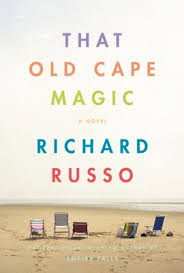 winning author Richard Russo. Fifty-five year old Jack Griffin watches as his thirty-year marriage to Joy quietly unravels. At the same time, he finds himself obsessed with remembering the eccentric and ultimately unsuccessful marriage of his late parents. The story opens with Griffin and Joy arriving separately at the wedding of a friend on Cape Cod, where they had honeymooned. Their daughter announces her engagement there, with her wedding to take place a year hence, in Maine.
winning author Richard Russo. Fifty-five year old Jack Griffin watches as his thirty-year marriage to Joy quietly unravels. At the same time, he finds himself obsessed with remembering the eccentric and ultimately unsuccessful marriage of his late parents. The story opens with Griffin and Joy arriving separately at the wedding of a friend on Cape Cod, where they had honeymooned. Their daughter announces her engagement there, with her wedding to take place a year hence, in Maine.In the course of that year, Griffin and Joy separate, Griffin's mother dies, and Griffin carries the ashes of both parents in the trunk of his car, unable to bring himself to dispose of them. Meanwhile, he reminisces about his childhood visits to the Cape with his parents, and he recollects scenes of his life with them. His "conversations" with them, even though they are dead, are more real to him than what happens around him.
Russo paints hilarious portraits of Griffin's Ivy League-educated parents who spend their careers teaching in a large state university in Indiana. Their devotion to Cape Cod and their competitive marriage provide plenty of opportunities for comedy and irony. The wedding of Griffin's daughter is another laugh-out-loud episode in this novel.
Set against the humor, though, is Russo's serious examination of what holds a marriage together and his illustration of how easy it is -- through lack of communication or pride -- to let go of a union built by two loving people over many years.
This book is more reminiscent of Russo's Straight Man than of his novels of middle class life set in New England and New York, like Empire Falls. It is also considerably briefer than many of his books, but it is funny, meaningful, and satisfying. Highly recommended.
Monday, August 3, 2009
Lackawanna County Library System Hosts Junior Battle of the Books

I've spent the last week catching up on my reading for this age group, since I'm going to be one of the judges. I've read four great books, selected by the LCLS youth services librarians.
The first book I read was Jeff Kinney's Diary of a Wimpy Kid. This very popular book is the first in a series that features Greg, who records his experiences and thoughts about sixth grade. His stories about popularity, friendship, and family are both funny and true.
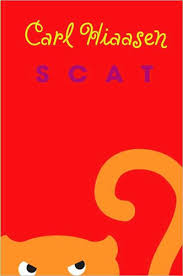
Next, I read Scat. In this book, Nick and his friend Marta find themselves swept up in a mystery that includes an endangered species, a wildfire, and their biology teacher. The book is written by Carl Hiaasen, best known for his mysteries for grownups.

I'm almost finished with The Watsons Go to Birmingham, 1963, by Christopher Paul Curtis. Ten-year-old Kenny Watson and his family live in Flint, Michigan. They head south to visit his grandmother in Birmingham, Alabama, during one of the most frightening times in the Civil
I have one more book to read before Thursday. It's called Chasing Vermeer, and it was written by Blue Balliett. It's another mystery, this time about the disappearance of a famous painting.
So far, all the books I've read have been really good and very interesting. The librarians did a great job of picking books that are appealing, fun to read, and full of good information. If you're in Grades 4 to 6, or if you know someone who is, I recommend that you read these books. They are all available at the Lackawanna County Library System library closest to you.
Thursday, July 30, 2009
Netflix vs. RedBox vs. Blockbuster -- What's the Best Deal?
What's the Best Deal?
Saturday, July 25, 2009
Review: Let the Great World Spin

McCann, Colum. Let the Great World Spin. (New York: Random House, 2009)
On the morning of August 7, 1974, Philippe Petit strung a wire between the new, not entirely occupied, twin towers of the World Trade Center in New York City. He proceeded to step out onto the wire, a quarter of a mile above the pavement, and walk across, eight times, for a period of 45 minutes, while office workers, commuters, and police looked on in wonder, admiration, and consternation.
Colum McCann tells the story of this aerial crime, enriching it with the stories of ten people who saw or were affected by the aerialist's action that day, including an Irish-born "street priest" in the South Bronx and his brother; Petit's sentencing judge, his wife, and son; mother/daughter hookers; and computer programmers on the West Coast. The reader is treated to a series of narratives that could stand alone as short stories, but that are, in the end, interconnected on the day of Philippe Petit's performance.
The novel introduces a stunning variety of social and historical issues that played out in the decade of the 1970's. The breakdown of social class is seen in the coming together of a group of mothers, mourning the loss of their sons in the Vietnam War, while celebrating their lives. The effects of poverty and drug addiction on women and children are illustrated by the "family business" of prostitution. The power of interlinked computers and telecommunications was in its infancy and creating excitement among the programmers who were thinking and dreaming big. The Vietnam War, moving towards its close in 1974, divided friends and family in New York City and elsewhere. The World Trade Center towers, newly constructed and occupied, represent a beginning in this novel, rather than the iconic destruction and terror we associate with them today.
Reading this novel, I was struck by the vast changes in communication between 1974 and the present. The Manhattanites on the sidewalk looking up at Petit paused in their busy lives to try to figure out what was happening 110 stories above them. They could not check CNN or their smart phones, as we would do today. They couldn't go online when they got to work to learn about what they'd seen. Computer programmers on the West Coast, who heard rumors of Petit's stunt, hacked into the phone system and began calling pay phones in New York City, hoping someone would pick up and tell them what was happening. In the era of the 24-hour news cycle and the Internet, it is hard to imagine how slowly, just 35 years ago, a sensational story could develop.
This book is extraordinary -- for its writing, for its depiction of 1970's New York, and for the way it captures the emotions of the lives being lived in its pages. Highly recommended.
Tuesday, June 30, 2009
Review: Await Your Reply
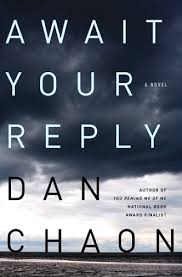
Await Your Reply, by Dan Chaon. (New York: Ballantine Books, 2009). Note: Scheduled publication date is September 2009. This review is based on an advanced reading copy.
The notion that we can be anybody we want to be takes on a new twist in this novel of aliases, identity theft, and fraud. Author Dan Chaon roams the permeable boundaries of self, as he demonstrates how easily his characters abandon old lives and assume new ones.
The main character of the novel is Hayden, variously described as a genius and a schizophrenic. We're never sure we meet him directly, though we come to know him through the reminiscences of his identical twin brother, Miles, and through the clues the author drops in the stories of the other characters in the book.
Miles, now 31 years old, has spent the last decade searching for his twin brother, who vanished at 21. He is unable to define his own life's path without knowing where his brother is. Hayden leaves clues to his ever-changing whereabouts in rambling late night phone calls and obscure letters, but Miles is always one step behind him.
Ryan, a college student who is about to flunk out of school, decides that his whole life has been a lie, when he hears some shocking family news. He disappears and begins a new life, on the wrong side of the law, with his uncle.
Lucy is a high school student whose parents died in her sophomore year. She takes to the road after graduation with her history teacher, who promises her a life of riches and excitement.
These stories, fascinating in themselves, are even more intriguing when the author pulls all the threads together. Chaon's character development is excellent, and he has an especially good feel for the young adults he creates. I highly recommend this novel. It's a great combination of literary fiction and a novel of suspense.
Friday, June 12, 2009
Midnight's Children
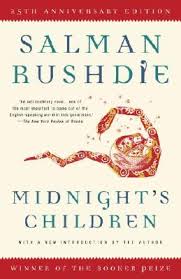
Midnight's Children, by Salman Rushdie. (Jonathan Cape, 1981)
Last year, Salman Rushdie's 27-year old novel, Midnight's Children, was honored as the all-time prize winning work of literature in the 40-year history of the Booker Prize.
The title refers to the babies who were born in the midnight hour on August 15, 1947, as India proclaimed its independence from Great Britain. The main character and narrator is Saleem Sinai, born on the stroke of midnight and destined to live a life that parallels the early struggles of the newly independent nation.
Saleem and the rest of Midnight's Children have unusual and extraordinary gifts and powers. Saleem's power is a telepathic one that enables him to communicate with the minds of others, and he uses his gift to virtually convene the Children who are spread throughout the geographic vastness of India.
Rushdie's writing is filled with history, magic, and humor. I'm currently two-thirds of the way through this book, and I am enjoying it immensely. I'm posting this information now, rather than waiting till I finish, so that I can share the news that Salman Rushdie is the next speaker in the Lackawanna County Library Lecture Series.
The lecture will take place on Friday, July 17, at 8 p.m., at the Scranton Cultural Center. As always, admission is free with a library card. Tickets are available at all Lackawanna County libraries, at the Scranton Cultural Center box office, or at the door the evening of the event.
Start reading Midnight's Children now, so you'll have time to savor and finish it before July 17!
Saturday, May 23, 2009
Choosing Books: A Potpourri of Recent Reads
I select
 ed The Goodbye Cousins, by Maggie Leffler, based on the recommendation of an author that I've already read and loved. Elinor Lipman commented, "I loved this book and loved its voice." Well, I love Elinor Lipman's voice, so if it's good enough for her, it's good enough for me.
ed The Goodbye Cousins, by Maggie Leffler, based on the recommendation of an author that I've already read and loved. Elinor Lipman commented, "I loved this book and loved its voice." Well, I love Elinor Lipman's voice, so if it's good enough for her, it's good enough for me. I often shy away from memoirs, especially those written by people I've neve
 r heard of. What can make the life of a heretofore unknown individual interesting enough to read about? I'm Down, by Mishna Wolff, had this intriguing note on its cover: "Mishna grew up in a poor black neighborhood with her single father, a white man who truly believed he was black." Cover quotes attest to the book's humor, and the publisher compares the author to Augusten Burroughs in her ability to "make you laugh and move you at the same time."
r heard of. What can make the life of a heretofore unknown individual interesting enough to read about? I'm Down, by Mishna Wolff, had this intriguing note on its cover: "Mishna grew up in a poor black neighborhood with her single father, a white man who truly believed he was black." Cover quotes attest to the book's humor, and the publisher compares the author to Augusten Burroughs in her ability to "make you laugh and move you at the same time."Sometimes, a title is enough to put you off what might be an otherwise wonderful book. That was t
 he case with The Sweetness at the Bottom of the Pie, by Alan Bradley. It is, in my mind, an odd and unappealing title. However, writer Laurie R. King, one of my favorites, praises it lavishly on the cover, and the publisher seals the deal with the following comment: "Meet Flavia de Luce, an aspiring chemist with a passion for poison, a taste for homicide, an obsession with delving into the forbidden past of her taciturn, widowed father ... and did we mention she's eleven years old?"
he case with The Sweetness at the Bottom of the Pie, by Alan Bradley. It is, in my mind, an odd and unappealing title. However, writer Laurie R. King, one of my favorites, praises it lavishly on the cover, and the publisher seals the deal with the following comment: "Meet Flavia de Luce, an aspiring chemist with a passion for poison, a taste for homicide, an obsession with delving into the forbidden past of her taciturn, widowed father ... and did we mention she's eleven years old?"One of the first books I blogged about was The Wednesday Sisters. Its author
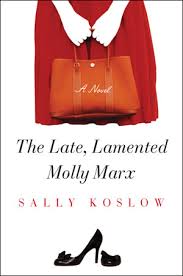 , Meg Waite Clayton, gives a warm recommendation to The Late, Lamented Molly Marx, by Sally Koslow. What really caught my eye, though, was the publisher's comment: "The circumstances of Molly Marx's death may be suspicious, but she hasn't lost her joie de vivre."
, Meg Waite Clayton, gives a warm recommendation to The Late, Lamented Molly Marx, by Sally Koslow. What really caught my eye, though, was the publisher's comment: "The circumstances of Molly Marx's death may be suspicious, but she hasn't lost her joie de vivre."All four of these books are quick, fun reads, and all are recommended.
Friday, May 1, 2009
Review: Handle with Care
Handle with Care, by Jodi Picoult. (New York: Atria Books, 2009)
Willow O'Keefe is a smart, funny five-year-old with osteogenesis imperfecta (OI), or "brittle bone" disease. Her first fractures occur in utero, and the next breaks take place just after her birth. Handle with Care examines the extraordinary pressures on the family, especially on the mother, of a child who needs so much care.
Willow's mother, Charlotte, once a successful pastry chef, now cares for her young daughter full time. She becomes an effective, even aggressive, medical advocate for Willow during her frequent hospitalizations for broken bones. Her focus on Willow creates a distance between Charlotte and her policeman husband, Sean, and makes her adolescent daughter, Amelia, feel invisible.
Charlotte sets in motion a "wrongful birth" lawsuit, alleging that her obstetrician, who is also her best friend, did not give her the critical information she needed that would have given her the option to terminate her pregnancy. Charlotte believes that a substantial legal settlement is the only way for Willow to have a comfortable life, especially after her parents are gone.
Because of the lawsuit and the pressure it creates, Charlotte finds herself adrift and distant from all the people she loves -- her husband, her best friend, and her older daughter. Even her lawyer finds Charlotte's lawsuit distasteful. Nonetheless, Charlotte pushes on, firm in her belief that her choice is the only right one.
This book is brimful of issues. In addition to a child with OI and a wrongful birth lawsuit, Picoult throws in divorce, bulimia, cutting, shoplifting, Catholic pro-life beliefs, medical malpractice, and an adult adoptee searching for her birth mother. While there are enough themes going on here to supply several books, they don't really get in the way of getting this story told. Narration is accomplished through a variety of characters, all of whom address themselves to Willow.
This is the first Jodi Picoult novel I've read, although she's been recommended to me by my librarian friends for years. The book has strong characters, a compelling storyline, and plenty of surprises. I'll have to begin looking at Picoult's "also by" list for more titles to read.
Thursday, April 9, 2009
Review: Outliers
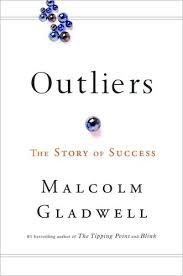
Outliers: The Story of Success, by Malcolm Gladwell. (Little, Brown and Co., 2008)
Malcolm Gladwell does it again. As in his earlier books, The Tipping Point and Blink, he rounds up research from a variety of sources to support an intriguing idea. In this case, he questions why it is that some individuals rocket to success, while others, with seemingly equal potential, achieve much less. He posits that an "outlier," someone who achieves at a level outside statistical norms, really owes his success to a variety of factors that are not in his control.
As he marches through a series of case studies and summaries of research, the author delivers the argument that the very successful benefit from opportunities as diverse as birth dates, parenting styles, and cultural legacies. In all cases, though, he points to the value of cumulative hours of work undertaken by his high achievers, whether he is talking about Bill Gates or the Beatles. While we assume that great success is bestowed upon those with outsize intelligence or ambition, Gladwell marshalls research and examines biographies to show how his selected "outliers" actually developed.
As the book progresses, the reader looks for, but does not find, any evidence or argument against Gladwell's chosen thesis. Nonetheless, the research he presents is intriguing and endlessly debatable. Outliers would make a great selection for a book discussion group.
Gladwell is an excellent writer, and he pulls the reader into his argument using fascinating and readable examples. While the ending is a bit indulgent, this short book, overall, is well worth your time.
Saturday, February 7, 2009
An Elinor Lipman Fest


Sunday, January 18, 2009
Review: The Good Thief

The Good Thief, by Hannah Tinti. (The Dial Press, 2008.)
A one-handed infant is dropped at the gates of a Catholic monastery in New England sometime in the 19th century. Ren, named for the three letters sewn into the garment he wears, spends his childhood dreaming of being reunited with his mother and father.
As a young teenager, he is released into the custody of a man who claims to be his long-lost brother. Benjamin is actually a con artist and snake oil salesman, who makes Ren his accomplice in life on the wrong side of the law. Ren, a naïf filled with innocence, faith, and prayer, is nonetheless accomplished at the art of light-handed theft and turns out to be of great value to his new benefactor.
Ren’s adventures on the underside of life are reminiscent of the picaresque novels popular in the 18th century. Many reviewers have compared the author’s work to that of Robert Louis Stevenson. The reader is treated to an ironic depiction of the many shapes that families can take. Beware: As this captivating story progresses, there is no shortage of violence, tragedy, or terror.
Recommended for adults and young adults, especially those who enjoy Dickens-style characters and adventures.



